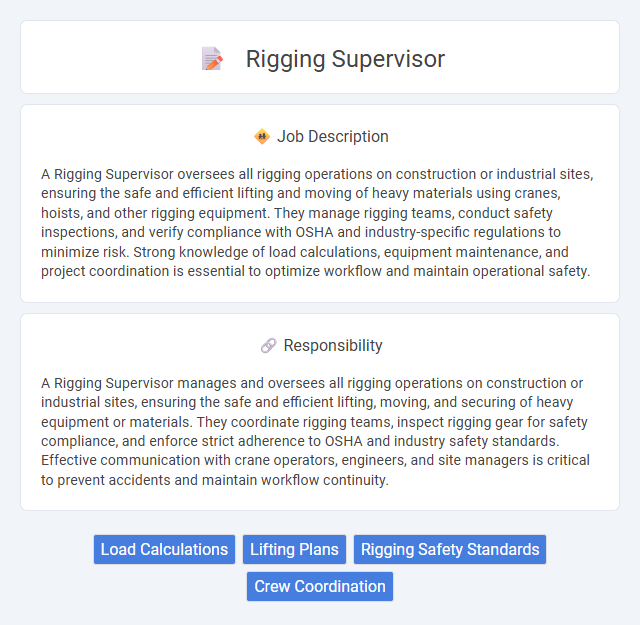
A Rigging Supervisor oversees all rigging operations on construction or industrial sites, ensuring the safe and efficient lifting and moving of heavy materials using cranes, hoists, and other rigging equipment. They manage rigging teams, conduct safety inspections, and verify compliance with OSHA and industry-specific regulations to minimize risk. Strong knowledge of load calculations, equipment maintenance, and project coordination is essential to optimize workflow and maintain operational safety.
Individuals with strong leadership skills and a keen attention to safety protocols are likely to be well-suited for a rigging supervisor role. Those who can handle high-pressure environments and communicate effectively with team members may have a higher probability of success in this job. Conversely, people who struggle with physical demands or lack organizational abilities might find this position challenging.
Qualification
A Rigging Supervisor must possess extensive experience in heavy equipment rigging, typically requiring a minimum of 5-7 years in supervisory roles within construction or industrial settings. Certifications such as NCCCO (National Commission for the Certification of Crane Operators) or equivalent rigging and crane operation credentials are essential to ensure compliance with safety regulations. Strong knowledge of OSHA standards, load calculations, and the ability to lead rigging teams under high-pressure environments are key qualifications for this role.
Responsibility
A Rigging Supervisor manages and oversees all rigging operations on construction or industrial sites, ensuring the safe and efficient lifting, moving, and securing of heavy equipment or materials. They coordinate rigging teams, inspect rigging gear for safety compliance, and enforce strict adherence to OSHA and industry safety standards. Effective communication with crane operators, engineers, and site managers is critical to prevent accidents and maintain workflow continuity.
Benefit
Rigging supervisors probably experience significant benefits such as enhanced leadership skills and increased industry knowledge, which can lead to higher salary prospects. They might also gain opportunities for career advancement due to their specialized expertise in managing complex rigging operations. Safety awareness developed in this role could potentially reduce workplace accidents, contributing to a more secure work environment.
Challenge
The role of a Rigging Supervisor likely involves navigating complex logistical and safety challenges to ensure efficient equipment setup and secure lifting operations. Managing diverse crews and maintaining compliance with rigorous safety standards may frequently test problem-solving and leadership skills. The position probably requires a keen ability to anticipate risks and adapt strategies under pressure to meet project deadlines successfully.
Career Advancement
A Rigging Supervisor oversees the safe and efficient setup of rigging equipment in construction and industrial projects, ensuring compliance with safety regulations. Career advancement often leads to senior supervisory roles or project management positions, offering increased responsibility and leadership opportunities. Mastery of industry standards, certifications, and hands-on experience are key factors driving upward mobility in this field.
Key Terms
Load Calculations
Load calculations are critical in the rigging supervisor role to ensure the safe lifting and moving of heavy equipment, preventing structural overload or failure. Precision in assessing weight distribution, center of gravity, and dynamic forces supports the development of effective rigging plans and the selection of appropriate gear. Rigging supervisors utilize software tools and industry standards such as ASME B30 to maintain compliance and enhance operational safety on construction and industrial sites.
Lifting Plans
Rigging supervisors are responsible for developing and overseeing detailed lifting plans to ensure safe and efficient material handling on construction or industrial sites. These plans include load calculations, crane selection, rigging equipment assessment, and compliance with safety regulations such as OSHA standards. Effective lifting plans minimize risk, optimize resource utilization, and enhance overall project safety and productivity.
Rigging Safety Standards
Rigging supervisors enforce strict rigging safety standards to prevent accidents and ensure secure lifting operations on construction and industrial sites. They oversee the inspection, maintenance, and proper use of rigging equipment such as slings, hooks, and shackles, adhering to OSHA, ASME, and ANSI regulations. Effective hazard identification, risk assessment, and safety training programs under their leadership are critical to maintaining compliance and protecting workforce safety.
Crew Coordination
A Rigging Supervisor leads crew coordination to ensure safe and efficient rigging operations on construction or industrial sites, managing teams of riggers to align with project timelines. Expert communication skills are utilized to synchronize tasks, allocate responsibilities, and monitor progress, reducing risks and avoiding delays. Proficiency in load calculations, safety protocols, and equipment handling enhances team collaboration and operational effectiveness.
 kuljobs.com
kuljobs.com